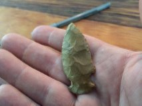 Last year I went with friends (who happen to be Historical Solutions alumni) on a fishing trip in central Ontario, Canada. It was a fly-in trip into the bush. One day late in the afternoon, after another fabulous day on a gorgeous lake, we were returning in our boats to the lodge. While in the boats, we spotted a narrow strip of what appeared to be a beach. We decided to land the boats there and take a closer look.
Last year I went with friends (who happen to be Historical Solutions alumni) on a fishing trip in central Ontario, Canada. It was a fly-in trip into the bush. One day late in the afternoon, after another fabulous day on a gorgeous lake, we were returning in our boats to the lodge. While in the boats, we spotted a narrow strip of what appeared to be a beach. We decided to land the boats there and take a closer look.
It was a beach of sorts, but a beach unique to the north woods and wilderness. More pebbles and rocks than sand, a thick interior of brush, trees, moss, and ferns just a few yards from the water line.
My first thought was that this was an ancient beach. It had likely been generations since many human tracks had dotted these shores, and only then in the handful of warm weeks during the brief summer.
And yet, as I walked amid the paw tracks of bear and hoof prints of moose, I looked down and saw this remarkable piece of shaped stone.
An arrow head.
How many decades old? How many centuries old? I’ll never know. But let’s you and I fit together a few things that we do know.
By its size in my hand, you can tell the arrow head is small, light, and delicate. It’s also rather durable; you would need to use some effort to break it in two. Together with its location on the beach, I think we can deduce that the primary usage was for fishing. The original maker and owner of the piece was likely Ojibwe, the predominant Indian tribe of the region.
Another step can be taken, too. I’m an avid reader of Sir Arthur Conan Doyle’s Sherlock Holmes and I believe we can employ one of Holmes’s most famous observations here:
“The curious incident of the dog in the night time” was, as Holmes said, worthy of note. “But the dog did nothing in the night time,” retorted the man. “That was the curious incident,” replied Holmes. (A striking line in a striking story, Silver Blaze.)
Our version of this for the arrow head is that we found nothing remotely similar to it in the vicinity. We looked and looked—as you might imagine—but nothing else turned up. The scene had a empty feel to it. The arrow head was a solitary figure.
From this we can speculate, with confidence I think, that this was an act of isolation and aloneness. The shot taken—or perhaps the equipment lost—was something by itself, not part of a static place or event. It was done and the owner moved on, either deeper into the bush away from the water or in his canoe back toward the center of the lake.
The piece was also once of something and was then no longer. It was once attached an arrow, tucked in a bag or pouch, or lodged in the flesh of a fish that was chewed, eaten, or decayed away to nothing. Again, becoming a solitary item that can be replaced, though only with effort.
The arrow head. One of the coolest things I’ve found in many a year. Does it conjure up something in your memory?







